May 13th, 2020 - My coronavirus assessment so far
Events, actions, and reactions are flying by so fast now concerning the coronavirus. This necessitates the composition of this piece at this specific time marker as I have watched closely as events unfold, and see shadows of motives and trends that lie underneath the surface. I also see how easily misinformation can steer consensus in the desired direction, and how common sense and best practices can be thrown by the wayside due to political agendas.
Let me proclaim that I am in no way a conspiracy theorist, and the commentary I am expressing is my analysis and evaluation of all of the moving parts, the public reactions whether sane or radical, and the possible motives of those who make the rules based on previously stated goals before this pandemic started. As Winston Churchill said, "Never let a good crisis go to waste."
I also intend to evaluate the current situation, follow the paths that led us here, and make commentary as to what we should have done, could have done, and should do when we are faced with these predicaments again.
The easiest thing to do at this point in time is to look back and criticize the government's response to each phase as it unfolded. This seems to be the pastime of many, but to be honest, we need to evaluate everything considering the environment that existed at that time and compare it to what we now know. To do anything other than that is dishonest. Anyone can be critical of an outcome without having to have made the choices with limited data that came before.
To properly assess the reactions our country has taken and the evaluation of conditions at that time, an early timeline is beneficial. These statistics may be boring, but I wish to show the relationship between what was known at the time and what responses were taken with the knowledge known. I will also need to refer back to this data.
I
have also added here the recommendations of Dr. Fauci, director of NIAID (National
Institute of Allergy and Infectious Diseases). Dr. Fauci's recommendations
are important because he is the one setting the guidelines. I must comment
here that his singular goal is to mitigate the spread of this virus, and all
other consequences of his decisions (such as economical) are not in his purview
and therefore not considered in his decisions.
Dec 31, 2019 - WHO
- A pneumonia of unknown cause detected in Wuhan, China was first reported
to the WHO Country Office in China.
January
2020 - WHO
- WHO is working 24/7 to analyze data, provide advice, coordinate with partners,
help countries prepare, increase supplies and manage expert networks.
January
21, 2020 - Dr. Fauci
- The coronavirus is not a threat here in the U.S.
January
30, 2020 - WHO
- The outbreak was declared a Public Health Emergency of International Concern.
January
31, 2020 - U.S.
- Declared the coronavirus a public health emergency.
- Announced Chinese travel restrictions.
- Suspended entry into the United States for foreign nationals who pose a
risk of transmitting the coronavirus.
February
2 - U.S. (CDC)
- The CDC expanded enhanced entry screening to eight major airports across
the nation.
February
3 - U.S. (CDC)
- The CDC had a team ready to travel to China to obtain critical information
on the novel coronavirus, but were in the U.S. awaiting permission to enter
by the Chinese government.
February
6 - U.S. (CDC)
- The CDC began shipping CDC-Developed test kits for the 2019 Novel Coronavirus
to U.S. and international labs.
February
9 - U.S.
- The White House Coronavirus Task Force briefed governors from across the
nation at the National Governors' Association Meeting in Washington.
February
11 - U.S.
- The Department of Health and Human Services (HHS) expanded a partnership
with Janssen Research & Development to "expedite the development"
of a coronavirus vaccine.
February
11, 2020 - WHO
- WHO announced a name for the new coronavirus disease: COVID-19
February
12 - U.S. (CDC)
- The CDC was prepared to travel to China but had yet to receive permission
from the Chinese government.
February
14 - U.S. (CDC)
- The CDC began working with five labs to conduct "community-based influenza
surveillance" to study and detect the spread of coronavirus.
February
18 - U.S. (HHS)
- HHS announced it would engage with Sanofi Pasteur in an effort to quickly
develop a coronavirus vaccine and to develop treatment for coronavirus infections.
February
22 - WHO
- A WHO team of international experts arrives in Wuhan, China.
February
24 - U.S.
- The Trump Administration sent a letter to Congress requesting at least $2.5
billion to help combat the spread of the coronavirus.
February
29 - U.S.
- The Food and Drug Administration (FDA) allowed certified labs to develop
and begin testing coronavirus testing kits while reviewing pending applications.
- Announced a level 4 travel advisory to areas of Italy and South Korea.
- Barred all travel to Iran.
- Barred the entry of foreign citizens who visited Iran in the last 14 days.
March
8, 2020 - Dr. Fauci
- Masks should not be worn as they are of little help in preventing the spread
and cause concern to others
April
7, 2020 - Dr. Fauci
- Do not shake hands with people
April
15, 2020 - Dr. Fauci
- Having sex with strangers who hook up via Tinder is acceptable as long as
they do not have symptoms and you are aware and willing to take the risks
May
12, 2020 - Dr. Fauci
- Wearing masks is essential in preventing the spread of the Covid-19 virus
May
12, 2020 - Dr. Fauci
- Opening up our schools too quickly is risky and it would be better to wait
for a vaccine
my comment: The Flu is a lot more dangerous to children under 18, see charts
below for Covid age groups)
(sources: https://www.donaldjtrump.com/media/timeline-the-trump-administrations-decisive-actions-to-combat-the-coronavirus/ , https://www.who.int/emergencies/diseases/novel-coronavirus-2019/events-as-they-happen ) except Dr. Fauci's comments which have been widely reported.

This is an addition to my original piece. I thought this would be relavant since I am comparing Covid-19 to the flu. Note that this does not show deaths, but the medical attention needed during the flu season was much larger than what we are dealing with now.
I have not included every action taken by the WHO, U.S., or Dr. Fauci, but note items that represent a pivotal point, have significant relevancy, or show decisions based on assumptions.
I am not planning to add data to this timeline as situations and opinions change, which they seem to do every day. The main purpose of this timeline is to show that statements and actions based on information expressed by "the experts" was and often are like shifting tides.
It is very important to be aware that Dr. Fauci and
Dr. Birx approached the Trump administration and using early models stated
emphatically that the U.S. needs to be shut down. We now know these models
were extremely flawed, and policy driven from these models seem to be flawed
as well.

I added this to my original composition to show the relevance of partial and full shut downs. Once this data was compiled, immediate action should have been taken to alleviate some of the pressure used to enforce severe restrictions.
It is often expressed that the U.S. was slow to react,
specifically pointing to February as the dormant month. It is important to
note that the WHO scientists did not arrive in Wuhan until Feb 22nd. As you
can see by the timeline, Most of February was spent on evaluation and plan
development. It is also important to look at the actual infection data that
existed in that period of time.

(source: https://www.cdc.gov/coronavirus/2019-ncov/cases-updates/cases-in-us.html)
January 24th marked the first case detected in the U.S. January 26th noted 3 new cases. January 31st saw 2 more cases. It wasn't until March 2nd that new cases hit double digits at 23. Statistics for all dates can be found at the above source.
The next piece of data to consider is the deaths which occurred from this virus in the early months.
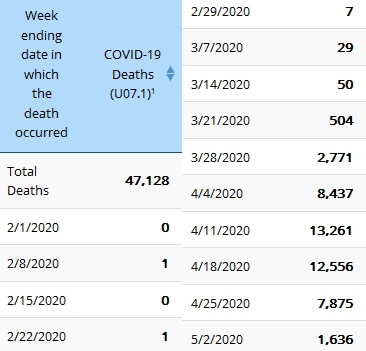
(source: https://www.cdc.gov/nchs/nvss/vsrr/covid19/index.htm
)
It is important to note that it wasn't until March 7th that deaths ascended into double digits. For those who complain about our slow reaction to events, the statistics and knowledge needs to be looked at carefully. We cannot use the information we know now to evaluate reactions then. Nor can we cite people who predicted the enormity of this pandemic and complain that they were ignored. Of all the predictions that were out there, some were wrong and some were right. If only there was a way to differentiate between the two and know beforehand which predictions would turn out to be correct. Shutting down the economy, quarantining at home, restricting movement, requiring masks, social distancing and shutting down businesses any time in February would have been a severe over-reaction based on the data. Could we have done better if our crystal ball had been working correctly? Maybe. But that is not reality or common sense, so we need to get over that.
I apologize again for putting all of these statistics ahead of my real issues, but I hear the screamers out there, and felt they needed to quiet down for a moment and view some actual facts so I can be heard.
When the virus was first reported, we spent time evaluating the scope, seriousness and potential actions we could take. The WHO and China were not forthcoming which left us with the task of finding solutions when the full scope of the virus was not yet known.
The primary concern was that should this become a pandemic, the medical facilities of this country could be overwhelmed. It is important to note that Covid was not declared a global pandemic until March 11th. In these early months we could only assume how many hospital beds we would need, how many gloves and masks, etc. would be required. I doubt we even fully understood what equipment and supplies we would need, and as we eventually realized, respirators would be the equipment most in demand. We are not normally stocked for pandemics. Consider the following:
An Associated Press review of more than 20 states found that before the coronavirus outbreak many had at least a modest supply of N95 masks, gowns, gloves and other medical equipment. But those were often well past their expiration dates - left over from the H1N1 influenza outbreak a decade ago.
"Since outbreaks and the resources needed are not predictable, purchasing a large stock of supplies that could expire or become obsolete is not a responsible use of state funds," the health agency said in a budget document submitted to Gov. Mike Parson and state lawmakers.
"You could see it in almost every state, in every locality, and the federal government level: depleting the resources, depleting the inventory, and hoping when you need them they will be available," said Gerard Anderson, a health policy professor at Johns Hopkins University, which has tracked coronarivus cases and deaths across the world.
Missouri
Health Director Randall Williams told the AP that it didn't make sense to
load up on supplies ahead of time without knowing what was needed. For example,
he said, bug spray would have been more useful than face masks during the
2015-2016 epidemic of the Zika virus, which is spread by mosquitoes.
"If you spend money on prevention and whatever comes your way isn't that, then you have less money for response" when an emergency occurs, Williams said.
(source: https://www.mercurynews.com/2020/04/23/review-state-stockpiles-were-depleted-before-the-virus/ )
At this stage in my essay, we can see the difficulties and challenges faced when dealing with pandemics. The best we can do is to acquire and compile information early so decisions can be made in a timely manner. We did not have this luxury. It does no good to react in a drastic manner based on assumptions, as any response will be costly and require great effort, and all in the hope that it is in the right direction. We cannot afford to waste resources chasing something down the wrong road.
After
all of this has been said, I will now provide my assessment and analysis of
events so far.
Although
early actions taken by our government seemed initially slow, I fully understand
the challenges it faced, and the uncertainty of direction given that valuable
data was slow to come. I am also aware of conflicting recommendations between
the WHO, Dr. Fauci, and our government. In many of these instances, the WHO
was on the wrong side.
I
condoned our social shutdown and social distancing guidelines. The purpose
was to be able to slow down the transference of this virus so as to provide
time to gear up our medical supplies and get our doctors, nurses, and hospitals
prepared for what could be rush hour squared. For the reasons already stated,
this took longer than expected. We ended up preparing for far more than we
needed in some places, with hospital workers getting laid off, and barely
able to keep up with the work load in other places. We are currently shipping
excess respirators to other countries that need them. This is par for the
course, as predictability is not in Covid's vocabulary.
We
also need to identify our most vulnerable, such as the elderly and unhealthy,
and zero in on protections for these groups. We have done a good job here
in some areas, and a terrible job in others. This is one thing that will not
change from pandemic to pandemic, so we need to learn from this and be able
to flip a switch in the future for these groups. This should not be hard,
no matter what other circumstances we are faced with.
Once we have these necessities in place, we should
be relaxing our restrictions on mobility and the ability to work. As important
as it is to do our best to keep us healthy, it is just as important to keep
our society functioning. We can do both with common sense precautions.
I feel that it is a great injustice to maintain and extend the lockdowns that are in place for the sake of "our safety." This virus is not something that will magically disappear if we only stay home long enough. The virus will be out there waiting for us to come out of our homes, ready to attack once again. No matter how long we wait, we will still experience the total impact eventually. We are simply delaying the inevitable. Not to sound like a doomsday seer, I'd like to mention that the ratio of those who get symptoms and those who are asymptomatic or have mild symptoms is encouraging. I'd like to also point out the significant percentage of deaths from this virus are those who are elderly or have other complicated health issues. As I said, these vulnerable people should have extra protection. So who is left but a population that should be able to withstand the impact of a virus such as this with the medical treatment that is now available. It hardly makes any sense for our society to still be on hold. I do not believe there is anything more for us to accomplish by doing so, but generates great harms that snowball each day these restrictions are in place.
Note these statistics:
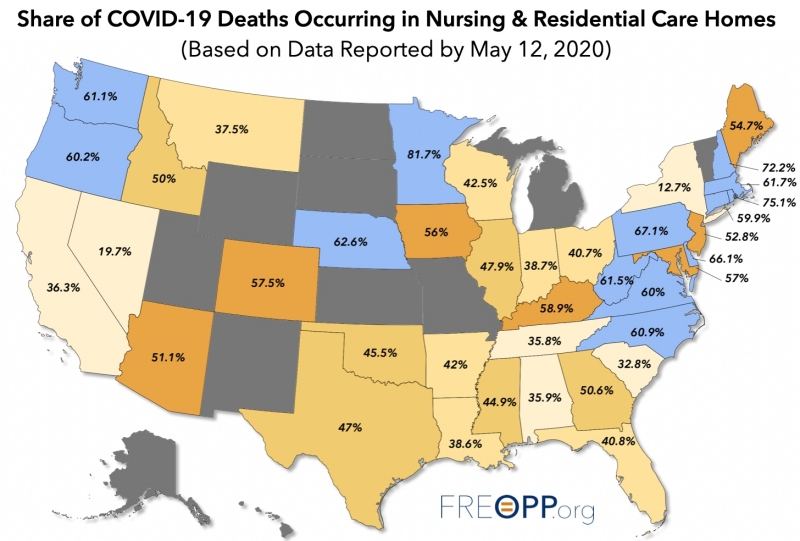
This
map shows the deaths of each state by percentage occurring in nursing home
and care facilities (some states not reporting). As I stated, this should
have been our number one focus, and shouldn't have been a surprise to anyone
that these people are the most vulnerable. If we took immediate action to
protect the vulnerable, our deaths would probably be halved. If that was the
case, would you be so afraid to return to something resembling a life?
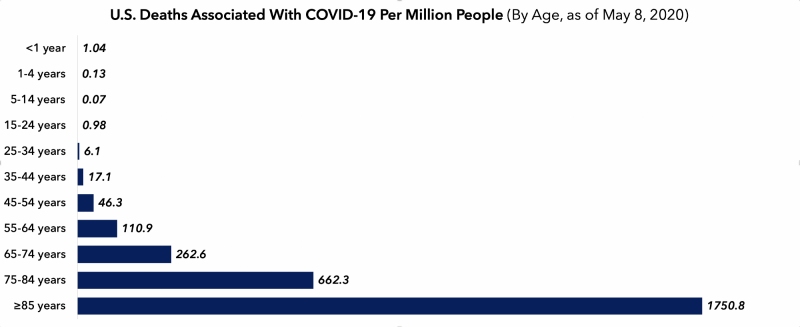
This graph shows U.S. deaths (per million people who had the virus) as of May 8th. I include this graph because the shutting of schools was a drastic event, and Dr. Fauci stated that schools should not reopen until we have a vaccine. Yet this chart shows that the impact on younger people is very small. We have yet to develop any vaccine for this entire family of viruses, and my guess is that by the time we have one, we will have an entire generation of illiterate and disadvantaged people. As of May 12th, 1,342,594 Covid-19 cases have been reported with 80,820 deaths. Compare this with the CDC's documentation that 80,000 deaths were reported last year due to the Flu.
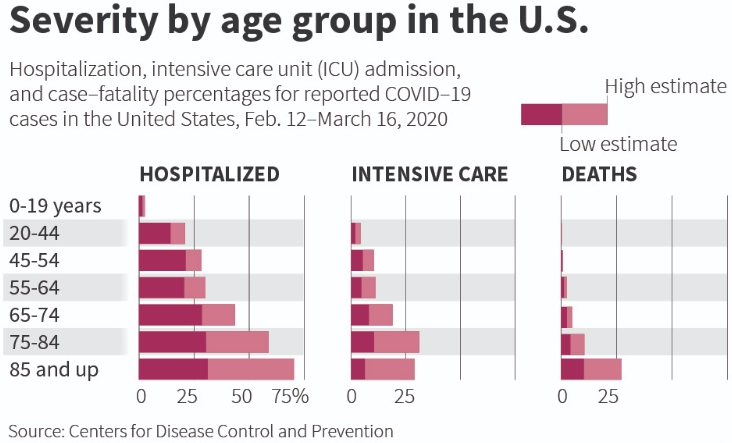
This
chart shows the relative severity by age as a percent between Feb 12th and
Mar 16th. Once again, we see that if our elderly and sick were protected,
the impact of this virus would be minimal. This chart does not show the overall
cumulative COVID-19 associated hospitalization rate, which is 4.6 per 100,000.
We
have gone from a shutdown so that we can prepare our medical sectors accordingly,
to shutting down to slow the spread of the virus to shutting down to force
the virus to go away. Why have these goal posts moved, and what are the motivations,
besides the ones we know of, like no money, no social interactions, restrictions,
fines, jail time, etc..
If you haven't noticed (and if you haven't, welcome back from Gilligan's Island), we have become a duplicitous society. Everything has become right or wrong, good or bad, green vs. brown, and it seems every issue has its sides without exceptions. There are lots of babies out in the street, having been thrown out with the bathwater. This virus is not immune to the split. It comes down to "every life is important" vs. "our way of life is important." In today's environment, they cannot both be true.
There
are those in governmental power that not only know this, but intend to capitalize
on it. The needless overreach, the restrictions and severity of punishments
for noncompliance, the mandates all test our constitutional system. I expect
the courts to be busy for some time to come. We have all seen the protests,
the examples being made, and the resistance on the news daily. If lockdowns
are no longer as valuable as they initially were, why are these battles being
waged?
I sincerely believe our society is being tested. Our government is like a child; boundaries will be tested and pushed against to see how far these boundaries can be moved. If you examine the agenda on the left, there are big plans for gun restrictions beyond common sense gun control, lifting restrictions on abortion, and the hundreds of limitations required to implement aspects of the green new deal. Much of these agendas require curtailed freedoms and restrictions that we are not currently subject to due to our constitutional rights. Currently, states have implemented ordinances and executive orders that conflict with our constitutional rights by using provisions in the state constitutions that these mandates are allowed if the purpose is to protect its citizens, or provides benefit to the majority. These exceptions provide loopholes for government to curtail rights that we all assumed we had. Judges, politicians and the public do not agree on many issues, such as the case of Shelley Luther. If you're not familiar, you should take a look. In this case it was the judicial that got it wrong and the political that got it right, sort of. The political created the standard, the judicial enforced the standard, and when the public cried foul, the political adjusted the standard. I expect this will be one of many battles to be fought in the months ahead.
I
also notice the battle lines that have been drawn:
- demanding the wearing of masks even when distancing / refusing to wear masks
when distancing
- keeping businesses closed / opening businesses
- maintain social distancing / use common sense with social distancing
- stay at home / go back to work
There are many more. It seems that those on the political left prefer the guidelines on the left while those on the political right lean towards the guidelines on the right (in actuality, dulling of the guidelines). I look at all of these issues not individually, but as objects belonging to a whole. The whole equates to: follow the rules / don't follow the rules
How many people will not look at the actual statistics, but simply believe everything heard on their favorite network? These networks have agendas too, serving the political party they support. It seems there is no shame today in reporting edited, misstated, or downright false information if the goal is to shame the other political party. It is past the time to reexamine the data, figure out who is most vulnerable, and make adjustments accordingly. Our country cannot withstand the extended marshal rule plan currently in effect. We need to compare the risks with the rewards honestly. We take risks every day, and navigate them in a responsible way.
I love the analogy my son used at one time to show the folly of curtailing risk by implementing severe restrictions.
In 2010, there were an estimated 5,419,000 crashes, 30,296 deadly, killing 32,999, and injuring 2,239,000.[2] About 2,000 children under 16 die every year in traffic collisions. Records indicate that there were 3,613,732 motor vehicle fatalities in the United States from 1899 to 2013.
https://en.wikipedia.org/wiki/Motor_vehicle_fatality_rate_in_U.S._by_year#cite_note-NHTSA10-2
https://www-fars.nhtsa.dot.gov/Main/index.aspx
Associate this with the following chart:
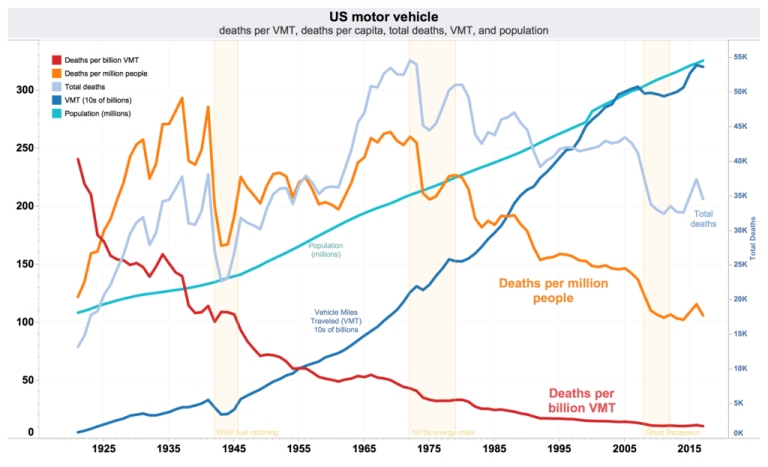
Chart
By Dennis Bratland - Own work, CC BY-SA 4.0, https://commons.wikimedia.org/w/index.php?curid=66179446
Take a look at the light blue line indicating total deaths due to auto accidents. In the last 10 years I quickly estimate maybe 35,000 deaths per year. That would be about 350,000 deaths. Now imagine that 10 years ago we passed strictly enforced laws that limited driving speed to 10 miles per hour. Chances are that most of these deaths would not have occurred. These are a lot of lives lost each year, and for those who insist that every life must be saved no matter the cost, would you be willing to set speed limits to 10 miles per hour to save these lives? (non-drivers' answers do not count)
I wanted to use this analogy to show that the cure must not be worse than the disease and all preventive actions must be commensurate with the risk. As of today, the medical "experts" continue to portray this pandemic in the worst case scenario (as this is their job and position) and the media is using any rebellion of this scenario as political tools in an effort to discredit the president's handling of this situation.
As
this political presidential cycle winds on, I see that Trump is advocating
for the reopening of our country while Biden said he would rely on Dr. Fauci
for all decisions concerning reopening. This shows the political division
that exists.
It is our medical expert team's responsibility to
report what they see on the ground and our politicians to weigh this information
against all other concerns. I do not advocate allowing non-elected single
goal experts to make decisions that have many other facets. I always love
when I have the opportunity to use a quote I coined, and it seems to be true
in this case, and that quote is "Experts are wrong 50% of the time".
(you can quote me!)
If we the people do not get our act together and stop drawing our battle lines at the political edge, we will all open our eyes one day and find that our rights have been severely pared. When we finally realize what has happened, it will be deemed to be water under the bridge, with the agenda pushers already declaring victory. It will become a long hard road back, and we will never regain all of the ground lost. This is why it is important to be vigilant of every word, motive, action, and proposal that surfaces. Americans are unique because we are the ones that decide how our politicians govern. We can only use this power wisely if we take the time to examine the facts and use common sense. It is useless to form our opinions based on the opinions of others. And in times like these, we can not afford to be caught sleeping.
Finally, I would like to say that situations are changing
daily, and data and projections should be adjusted accordingly. Some states
are starting to reopen while others are remaining closed. Any reopening will
increase virus infections. This is pretty much guaranteed. If we wait for
3 more months and then reopen, we will experience the same resurgence. If
we wait too long, the economy as we know it will no longer exist. If we opened
100% tomorrow, many small businesses will still fold. We are already past
the point of minimal damage to our economy. And, whose back is it on to repay
the trillions of dollars we are spending to keep this intentional economic
shutdown afloat? We will indeed once again be passing this debt on to our
children and grandchildren.

